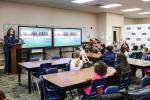Early returns show ‘zoom’ schools boost ELL students
There is no more important issue for Nevada’s economic future than to get education reform right.
Nevada has the fifth-highest population of children who come to school speaking a language other than English, or per the federal government’s definition, English Language Learners. In the Clark County School District, one in four children in kindergarten through third grade is an ELL child. Because of the high number of ELL children in Southern Nevada, their acculturation and success in school is key to this region’s future workforce productivity. Nevada will raise its education ranking only if it gets ELL education right. For example, Nevada’s graduation rate for ELLs of 29 percent, compared with the national rate of 57 percent, needs to improve.
In 2013, Gov. Brian Sandoval and the Legislature took a courageous first step by embarking on reform focusing on English Language Learners. Senate Bill 504, known for “zoom” school investments, also sets ELL policy, mandates strategic planning and reviews teacher training. CCSD has made zoom school funding available to 14 schools covering 11,000 students, 56 percent of whom are ELL, with 96 percent from poverty backgrounds.
Lasting reforms require resources as well as changing the usual way of doing things. Taxpayers should know whether zoom investments have translated into better student outcomes. Has Nevada made the pivot toward better outcomes for ELL children?
The traditional measure of student achievement is state assessments. Nevada is in a transition year in standardized testing, because of the introduction of Common Core. CRT 2013-14 results show that zoom schools experienced statistically significant growth in reading proficiencies, increasing by 4 percent to an overall group score of 47 percent. Even though the overall proficiency score is low compared with CCSD’s 65 percent score, this is movement in the right direction.
Nevada School Performance Framework ratings for zoom schools measure both growth and actual proficiency. Both are important. Kids need to be proficient by the end of grade school to be ready for middle school. However, in this first year of the zoom school project, the focus should be on improvement. When these reforms take hold, within two to three years, it will be fair to judge zoom schools on their actual proficiency levels and NSPF ratings.
The second point of evaluation is whether these investments promote real reforms. Have CCSD zoom schools adopted reform policies that ensure taxpayers’ investments are not wasted? Again, the answer is so far, so good.
CCSD’s 14 zoom schools were grouped into a discrete performance zone under the supervision of one academic manager. New systems were put in place focusing on curriculum appropriate for ELL and poor children. There was new focused professional development. Zoom reading centers put in place ELL-focused literacy programs emphasizing comprehension. A zoom school parental engagement coordinator ensured that each school had in place outreach that was academically focused and culturally appropriate. This coming year, CCSD will partner with Communities in Schools, and 12 zoom schools will have on staff a community worker helping students and families resolve nonacademic barriers to achievement.
All zoom schools have pre-K and full-day kindergarten, with class sizes small enough so that teachers can develop academic skills. The results are promising. By the end of kindergarten, between 80 and 90 percent of children knew all of their letters and sounds and were beginning to write. The results of pre-K were even more encouraging. By spring 2014, about 90 percent of children were “ready to read,” according to CCSD’s observational assessment.
In zoom reading centers, currently geared to grades K-3, 40 percent of children caught up to their grade level during just one year of one-on-one tutoring. Close to 500 children are now on track for reading success.
So far, so good. Of course, there are still areas where CCSD should re-evaluate and make adjustments to its zoom school innovations. Nonetheless, these early results indicate that CCSD is leading the way in ELL innovation. Let’s keep the momentum.
Sylvia Lazos is a professor at the William S. Boyd School of Law at UNLV and co-chair of the Education Committee of the Latino Leaders Council.























